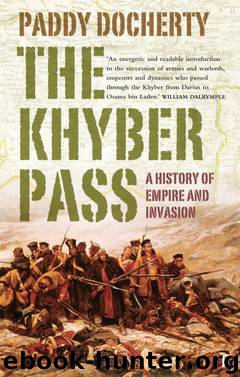The Khyber Pass by Paddy Docherty

Author:Paddy Docherty [Paddy Docherty]
Language: eng
Format: epub
ISBN: 9780571317363
Publisher: Faber & Faber
Published: 2014-03-01T16:00:00+00:00
Mahmud was therefore doing the work of God by seizing the treasure of the Indians. Moreover, many of his campaigns combined plunder with iconoclasm, exploiting the happy coincidence that some of the wealthiest targets in India were the many temples richly endowed to service and celebrate a Hindu idol. There was therefore a strong element of convenience in Mahmud’s claim to be a hammer of idolaters – he was willing to make war on Muslims too when they had bounty to be seized – but he was nonetheless awarded titles and honours by the caliph in gratitude for his violent furthering of the cause of Islam.
In the campaigning season of 1018, the sultan allied iconoclasm with profit when he struck deep into India to attack the city of Mathura, eighty miles south of Delhi on the Jumna river. As the reputed birthplace of Krishna, Mathura is one of the holiest shrines in India, but Mahmud found it barely defended and was able to plunder freely and destroy its temples without hindrance. There can be no doubt that the treasure taken was plentiful, but it is hard to believe the stories that tell of the seizure of five gold idols, each five yards in height, and of a sapphire weighing over 16 lb. Nonetheless, the booty was great, and it may well be true that the gold seized weighed over 548 lb, as is recorded. Plunder taken elsewhere on this campaign included over 380 elephants and an extraordinary 53,000 slaves.
The most famous iconoclastic effort of Sultan Mahmud was, however, not his attack on Mathura, but his 1024 campaign against Somnath. Sitting on the coast of the Indian Ocean in what is now Gujarat, the great temple of Somnath might have seemed safely removed from the arena of regular Muslim raids; hundreds of miles separated the city from the Punjab and the Ganges valley, the areas that bore the brunt of the Turkish incursions. The temple of Somnath was dedicated to Shiva, Lord of the Moon, and stood above all others in India for its rich endowments and the extravagance of its worship: 3,000 Brahmin priests prayed at the temple every day, and over 300 dancing girls and religious prostitutes were in constant attendance on the idol, working in relays to ensure that dances were performed without end. The endowments of the temple that provided for such dedicated worship were said to amount to the revenues of 10,000 villages. The idol that stood at the centre of all this attention, the sacred object of the devotion of thousands, was a giant penis, carved in stone and standing three yards high.
The stories of the wealth of Somnath had reached the ear of the sultan, and he launched a bold thrust all the way to the sea to seize these legendary riches, an arduous undertaking that required a hazardous desert crossing. with his ruthless ability to find means of overcoming obstacles – in this case, 30,000 camels loaded with water – Mahmud’s army reached the city walls of Somnath in around January 1025.
Download
This site does not store any files on its server. We only index and link to content provided by other sites. Please contact the content providers to delete copyright contents if any and email us, we'll remove relevant links or contents immediately.
| Africa | Americas |
| Arctic & Antarctica | Asia |
| Australia & Oceania | Europe |
| Middle East | Russia |
| United States | World |
| Ancient Civilizations | Military |
| Historical Study & Educational Resources |
Surviving the Forgotten Genocide by John Minassian(751)
The March to Kandahar: Roberts in Afghanistan by Rodney Atwood(537)
Journeys on the Silk Road by Joyce Morgan(490)
The Khyber Pass by Paddy Docherty(489)
The March to Kandahar- Roberts in Afghanistan by Rodney Atwood(439)
Dictators Without Borders: Power and Money in Central Asia by Alexander A. Cooley & John Heathershaw(411)
The Steppe and the Sea by Thomas T. Allsen(399)
The First Afghan War 1839-42: Invasion, Catastrophe and Retreat by Richard Macrory(391)
Tang China in Multi-Polar Asia (The World of East Asia) by Wang Zhenping(361)
Dictators Without Borders: Power and Money in Central Asia by Alexander A. Cooley Ph.d. & John Heathershaw(355)
Hopeless but Optimistic by Douglas A. Wissing(353)
Afghan Hindus and Sikhs by Inderjeet Singh(343)
Churchill's First War by Con Coughlin(339)
Historic Treasures of Uzbekistan by Peter Clarke(278)
